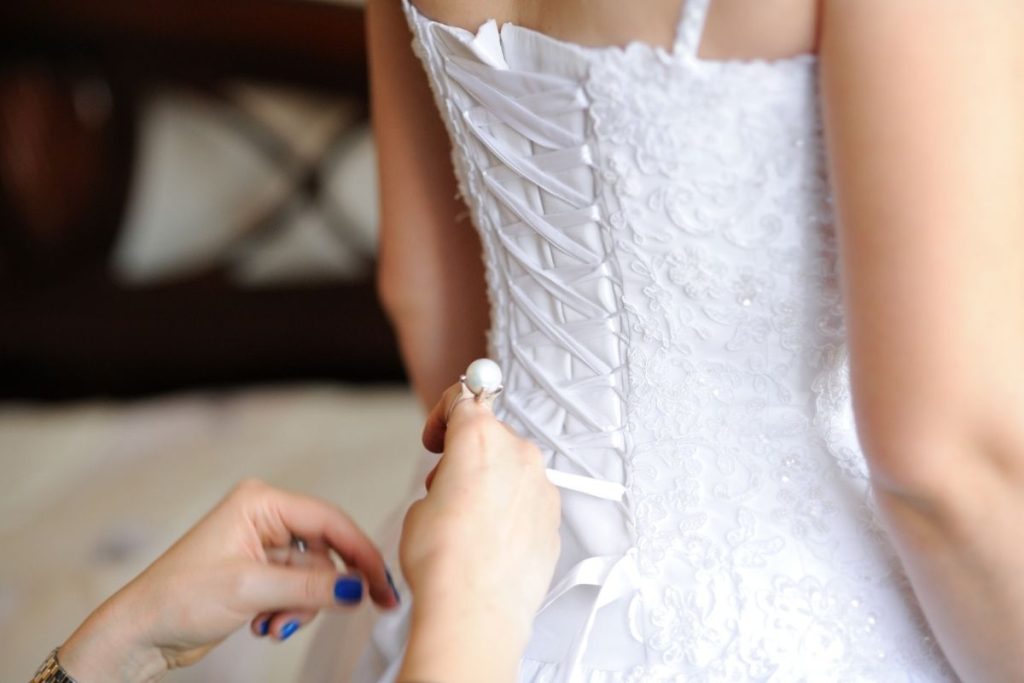Purity and good morality have been long associated with the white color, which is one reason why some brides choose to wear it, particularly in the West. However, you will often hear assertions that brides wear white because it’s “tradition.” White was not the only color worn for wedding gowns, however. Other hues were chosen significantly more frequently than white throughout history.

Up until quite recently, wedding gowns have been available in a variety of colors across Western civilizations. This was for sentimental and practical reasons. Brides often bought a second wedding dress or simply wore the best one they owned. Because it is difficult to keep clean, white isn’t particularly practical: it’s not great for many situations or repeat usage. Many brides have chosen to wear dresses of various colors at their weddings and beyond. So, why do so many contemporary brides choose to go dressed in white?
When we think of western weddings, we usually think of beautiful white gowns that we can seldom afford. Many women will begin daydreaming about their fairy tale wedding ceremony, and, without a doubt, one of the most spectacular aspects is the wanted white gown.
If you’re like most people, you probably believe that this custom is thousands of years old. It would surprise you to learn that this tradition is relatively recent in the West. In this blog, you’ll discover how white wedding gowns came into existence and why brides choose such a hue.
A history of the traditional wedding dress
In recent days, white wedding dresses have been overwhelming us with their loveliness and simplicity. When Queen Victoria first emerged from her carriage in her white dress, the guests were unimpressed. A royal bride would usually wear fur, gold embroidery, and vibrant colors to impress the crowd! As a result, it’s easy to see why the dress’s original impact was rather limited.
Hundreds of years ago, royal weddings were more about money and political deals than love; therefore, they anticipated riches and gold. A good example is Margaret of York’s 1468 wedding gown that was so heavy with gems that she was carried to the church! A wedding guest pulling up your dress when you go to the ladies’ room is a significant leap! So, when Queen Victoria appeared in her basic white gown, she was making quite an impression.
Why do brides wear white?
So, why are wedding gowns typically white? It was far more common many years ago for ladies to pick different colors over white as their wedding clothes. In certain cultures, brides wore dresses that were a variety of colors rather than just one or two. This was primarily due to practicality.
We’re used to buying a wedding gown that we’ll only wear once and then put away for good. However, many brides decided to wear their most acceptable dress, whether it was already theirs or not.
Why wedding dresses are white?
The tradition of wearing white to a wedding began with Queen Victoria’s 1840 marriage to Prince Albert. White was previously an uncommon gown color due to its impracticality (white is difficult to keep clean) and expense (only the wealthiest could afford a white dress that could only be worn once). Mary Queen of Scots wore a white wedding gown in 1559, but it was the only notable occurrence.
When Queen Victoria and Prince Albert got married, wearing a white gown became highly fashionable. Royal weddings in the distant past, much like today’s royal wedding (remember blushing when Meghan Markle looked stunning during her marriage to Prince Harry), were also largely publicized, although not through nearly as many means. This means that, like today, royal weddings had a propensity to lead the fashion pack. With each event, the fashionable standards set by the new royals rise higher and higher. And if history is any indication, we can expect to see more ivory gowns in the future.
When Queen Victoria went out in a white gown, several newspapers and periodicals chronicled her fashion choice. The decision to wear a white gown was said to be so she could exhibit the exquisite lace detail from the British lace industry. Following this, many richer brides embraced fashion! They donned white wedding gowns, and as a result of this trend’s spread across all social strata levels, it was termed “tradition” in the 20th century.
Today, lace is still a popular and elegant choice for weddings. That’s why we offer a variety of wedding dresses at Occasions Bridal, all with exquisite lace detailing. Our favorites include: Beth from the Le Papillion collection, Annabel from the Modeca Bridal collection, Isabelle from the Bianco Evento collection, and Artemis from
Many cultures, however, continue to wear various hues. In China and India, brides are dressed in red as a symbol of good fortune. Nigerian weddings traditionally feature brightly colored and flamboyantly adorned gowns. Each family in Ghana has its own distinctive fabric pattern.
There were a variety of reasons why Queen Victoria chose to wear white. Her gown was trimmed with hand-made Honiton lace, which was beginning to lose popularity at the time. Her wide reach might help the lace industry recover. White was the greatest way to showcase the lace artists’ craftsmanship.
Her second objective was to make her vows to her spouse as the woman he loved, with an unspoiled spirit, over a monarch. This is why she avoided precious family heirlooms. White denotes purity, innocence, and innocence.
Wedding gowns have been available in a variety of colors across Western civilizations. This was for both practical and sentimental reasons. Brides often bought a second wedding dress or simply wore the best one they owned. Because it is difficult to keep clean, white isn’t particularly practical: it’s not great for many situations or repeat usage.
In a nutshell, you’ve discovered some fascinating information about why wedding gowns are white, and we’ve completely answered the question, “why do brides wear white?” It surprises us to learn that the lovely white wedding gown isn’t a tradition. Did you know that Queen Victoria is credited with starting the trend?
